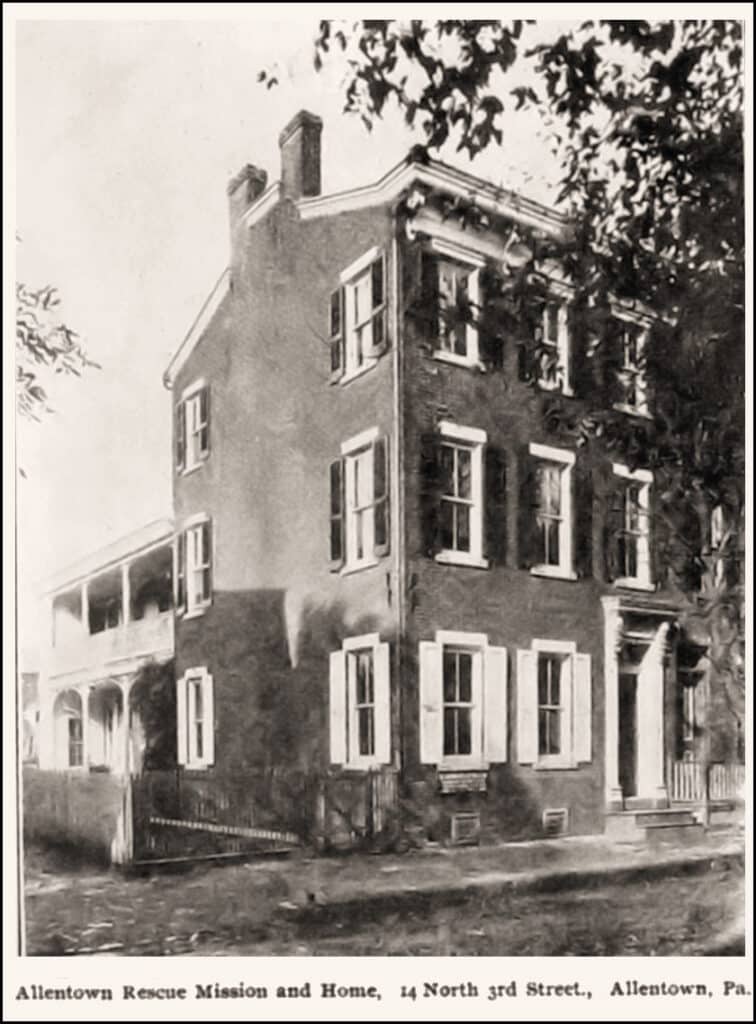The goal of the Allentown Rescue Mission is to rescue, rehabilitate, and restore homeless men. Since 1900, dedicated employees, volunteers, and donors have worked hard to understand and address the needs of homeless men in our community.
We are a non-denominational, social services organization that provides critically-needed goods and services to homeless men regardless of race, color, creed, national origin, sexual orientation, or religion. The Allentown Rescue Mission is not a church but does cooperate with various churches concerned about poverty and homelessness.
Our motivation for helping those less fortunate goes back for more than 100 years. We believe that we all deserve a second chance and work to provide hope and renewal to the homeless men of the Greater Lehigh Valley.

“Ten years ago I was called to be a Rescue Mission Worker. I said I could not do it,” said Obadiah Becker, the Mission’s founder, at a National Federation of Gospel Missions convention in 1908. “I wrestled with it for two years because I did not feel I was well enough educated. When I wrestled with the Lord, He laid it on my heart to work for the cause of rescue missions-a poor drunkard to wrestle with the work of God.“
“About that time our little baby fell and struck the back of her head. Three weeks after the accident, she fell over, and one side of her body was completely paralyzed. I prayed to God that our baby might be saved.“
Obadiah prayed that if his daughter would get well, he would take it as a sign to dedicate his life to rescue work.”My prayer was answered,” Obadiah explained. “The little girl is now running around, and I have consecrated my life to the work of God.”
Beginning in 1900, he and Mrs. Becker ran the Allentown Rescue Mission in rented apartments at 104 N. 7th Street, and four years later at 161 Hamilton Street. Upon inheritance of Mrs. Becker’s family home at 14 N. 3rd Street, it was remodeled to accommodate 200 worshippers and lodge 78 men.
It has been located at 355 Hamilton Street since 1961. Since the early 1900’s, the Allentown Rescue Mission’s goal for each man is self-sufficiency. The 1906 Allentown Rescue Mission statement explained their work: “The rescue of men who have been wrecked by sin, and who are desirous, by the help of God, to lead Christian lives… It provides a home for those who want to lead better lives until such a time when Christian manhood is established, and it is safe for them to live elsewhere in a good home.”
For more than a century, the Allentown Rescue Mission has addressed the changing face of homelessness, tackling the root causes of homelessness, and helping to end homelessness one life at a time throughout the Lehigh Valley. Thousands have come to us and received life-changing help throughout the decades:
Battered soldiers returning from World War I were welcomed by the Allentown Rescue Mission. Thousands of hungry victims of the Great Depression were fed at the Allentown Rescue Mission in the 1930s.
In the 1940s and 1950s, the Allentown Rescue Mission aided many shell-shocked veterans of World War II and Korea. As the drug culture emerged in the 1960s and as serious forms of addiction increased in the 1970s, the Allentown Rescue Mission coped and adapted, striving to meet the needs of each man who came for help.
In the 1980s, the problem of homelessness became highly visible, due in part to the “de-institutionalization” of the mentally ill. Many people could not cope when they were put on medication and released.
Highly-addictive crack cocaine and the disease AIDS continued to increase the complexity of homelessness in the 1990s.
In 2008, the recession and the housing market collapse forced people out of their homes and increased the need for shelters like the Allentown Rescue Mission. The Mission kept its doors open throughout the COVID-19 pandemic, thus ensuring that homeless men had a safe harbor during those unprecedented times.

© 2024 All Rights Reserved | EIN: 23-6005983 | Policies